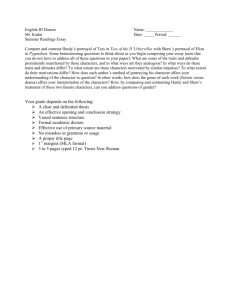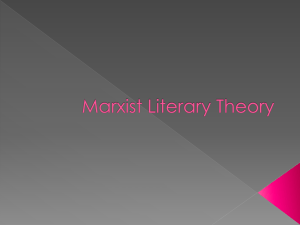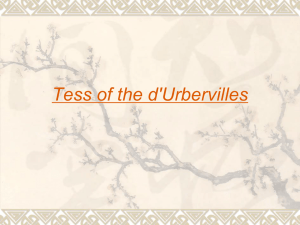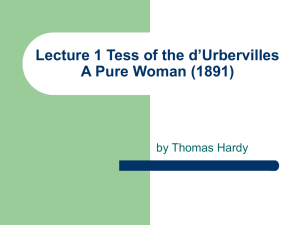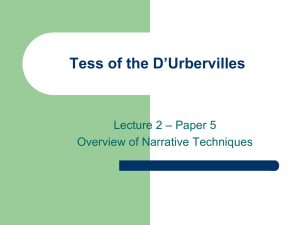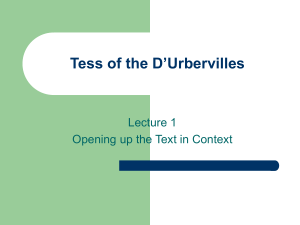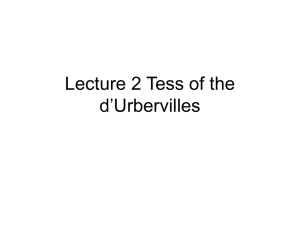5 - APE LIT Survival Guide
advertisement
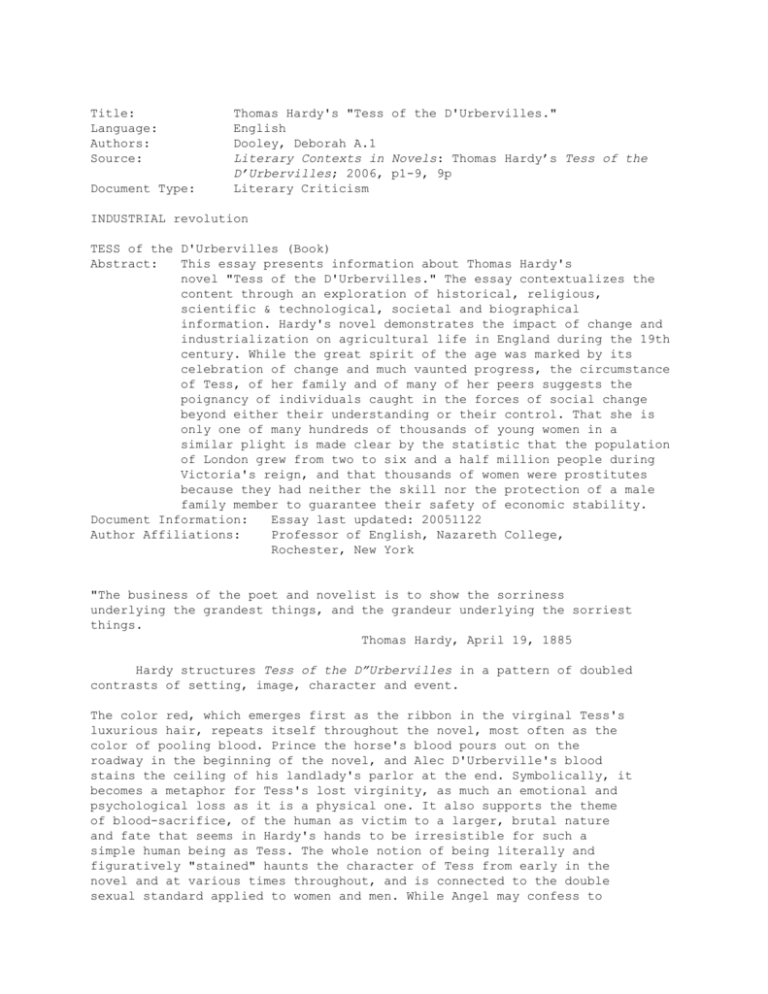
Title: Language: Authors: Source: Document Type: Thomas Hardy's "Tess of the D'Urbervilles." English Dooley, Deborah A.1 Literary Contexts in Novels: Thomas Hardy’s Tess of the D’Urbervilles; 2006, p1-9, 9p Literary Criticism INDUSTRIAL revolution TESS of the D'Urbervilles (Book) Abstract: This essay presents information about Thomas Hardy's novel "Tess of the D'Urbervilles." The essay contextualizes the content through an exploration of historical, religious, scientific & technological, societal and biographical information. Hardy's novel demonstrates the impact of change and industrialization on agricultural life in England during the 19th century. While the great spirit of the age was marked by its celebration of change and much vaunted progress, the circumstance of Tess, of her family and of many of her peers suggests the poignancy of individuals caught in the forces of social change beyond either their understanding or their control. That she is only one of many hundreds of thousands of young women in a similar plight is made clear by the statistic that the population of London grew from two to six and a half million people during Victoria's reign, and that thousands of women were prostitutes because they had neither the skill nor the protection of a male family member to guarantee their safety of economic stability. Document Information: Essay last updated: 20051122 Author Affiliations: Professor of English, Nazareth College, Rochester, New York "The business of the poet and novelist is to show the sorriness underlying the grandest things, and the grandeur underlying the sorriest things. Thomas Hardy, April 19, 1885 Hardy structures Tess of the D”Urbervilles in a pattern of doubled contrasts of setting, image, character and event. The color red, which emerges first as the ribbon in the virginal Tess's luxurious hair, repeats itself throughout the novel, most often as the color of pooling blood. Prince the horse's blood pours out on the roadway in the beginning of the novel, and Alec D'Urberville's blood stains the ceiling of his landlady's parlor at the end. Symbolically, it becomes a metaphor for Tess's lost virginity, as much an emotional and psychological loss as it is a physical one. It also supports the theme of blood-sacrifice, of the human as victim to a larger, brutal nature and fate that seems in Hardy's hands to be irresistible for such a simple human being as Tess. The whole notion of being literally and figuratively "stained" haunts the character of Tess from early in the novel and at various times throughout, and is connected to the double sexual standard applied to women and men. While Angel may confess to many lovers and expect to be forgiven, Tess's experience of sexual abuse and her resulting pregnancy is sufficient for Clare to abandon her and their marriage on their honeymoon night. Angel Clare is starkly contrasted yet also shares dimensions of Alec D'Urberville. Neither man is capable to seeing Tess as a person with real needs, feelings and desires. While Angel's interests in her are perhaps less rapacious than Alec's, he is as much as is Alec the agent of her downfall when she fails to comply with his pre-established image of his lover, wife and life-partner. His failure to see her with 'clarity' and to genuinely provide and care for her makes his name as ironic as Alec's, a degraded conqueror and master of Tess's body and life. Tess's innocent if voluptuous beauty is contrasted with the prim control of Angel's sometime love interest, Miss Mercy Chant, and with the hardened lives and bodies of the women workers whose lives, at various times, she shares. The life of country people like the Durbeyfields is contrasted with the more urbane worlds inhabited by those with more resources, like Angel's family and the D'Urbervilles, and even with the Talbothay's whose land is their own and whose security is thus guaranteed. The luxuriant, green, pastoral world of the Froom Valley where Talbothay's dairy lies stands in stark contrast to the grim and sterile world of Flintcomb Ash and Tess's earlier experience binding sheaves behind a reaping machine. The notion of "paradise lost", of a spoiled Edenic world with a machine now having invaded the garden was a powerful one in a rapidly industrializing 19th century. This is an instance of Hardy's using setting for symbolic value and social commentary. The theme of Tess as sacrificial victim is clinched at the end of the novel as she lies sleeping on a flat, altar-like rock at Stonehenge, a place of primitive worship and probably animal or human sacrifice. She enters the circle of sacrifice and is herself surrounded by her captors; she is executed inside the walls of the Wintoncester prison by hanging, as the circle becomes a noose. Thus does Hardy counter-pose the crushing determinism of Darwinism with the individual and so the tragic free will of Tess. It is sometimes argued that the departing Liza-Lu and Angel Clare are meant by Hardy to echo the fallen Adam and Eve after the loss of Eden. Like Adam and Eve, Angel and Liza's fall is a "happy" one, because despite their loss of innocence and of their beloved Tess, they can go off, sadder and wiser, into the larger world and make a new life together, perhaps with a new 'promised land' in their future. Historical Contexts Hardy's novel functions in a summative way to demonstrate the impact of change and industrialization on agricultural life in England during the 19th century. The noise, speed and pervasive presence of the steam-driven locomotive were only one of the machines that brought both progress and its accompanying destruction to rural England. Whether it is a reaping machine or a steam-driven loom, the lives of workers in England became increasingly miserable, and the lives of the titled and land-owning increasingly comfortable. The type of exploitation in the novel of agricultural workers, many of whom were women, is paralleled to that of textile and other factory workers in urban environments. To describe this gap between wealth and its accompanying social status and poverty with its accompanying misery, novelist turned Prime Minister Benjamin Disraeli coined the term "two nations," perhaps the most repeated phrase of social criticism in all of the 19th century. While the great spirit of the age was marked by its celebration of change and much vaunted progress, the circumstance of Tess, of her family and of many of her peers suggests the poignancy of individuals caught in the forces of social change beyond either their understanding or their control. Neither the erection of the Crystal Palace in 1851 in Hyde park to exhibit and celebrate the Works of Industry of all Nations, nor the rising tide of Evangelicalism with its emphasis on piety and hard work embraced by the English middle class, nor the publication of Darwin's Origin of the Species in 1859, nor the Higher Criticism of the Bible and its accompanying agnosticism among English intellectuals, nor Marx's and Engels' critique of the exploitation of the worker would most probably have been known to a woman like Tess. But in the novel that bears her name, Hardy brings all of these elements of the Victorian zeitgeist to bear. Thus historical England comes to profoundly inform the social criticism affected by its art. Societal Contexts Like many novels of the late 19th century period, (called the Victorian Age because Queen Victoria remained on the throne from 1837-1901) Hardy's novel was published first in serial form. As such, it faced the rigorous censorship of Victorian critics, who demanded that no mention be made of Tess's pregnancy and that Hardy's subtitle in the 1891 draft of the title page, "A Pure Woman, Faithfully presented by Thomas Hardy" be omitted. Increasing efforts through this century to impose rigid control on women's bodies and their movements and to maintain silence about such natural functions as sex and childbearing, parallel an intensified economic dependency on men faced by women at this time. A single event is sufficient to throw a family into desperate straits, and often women and children are the most easily victimized by circumstances beyond their control. The loss of the family horse and the shiftlessness of her alcoholic father and co-dependent mother make Tess ripe for the opportune exploitation that Alec so effectively seizes upon. Upon the death of her father, his wife and children lose the lease to the family house and land. Tess's dependency is thus driven by her class, but more fully by her sex and the social censure that so effectively ignores the degree of the economic and sexual victimization she experiences at Alec's hands. Her dependency is also driven by English law, which maintained a woman's circumstance as the possession of her husband, much like his animals, his lands, and his furniture. And so Alec can say to Tess with impunity: "I was your master once! I will be your master again. If you are any man's wife you are mine." The loss of her virginity, her resulting pregnancy, the censure of the church and her fears for herself and her family's survival, her physical, emotional and even spiritual abandonment by her husband, truly leave Tess alone in the hands of a fate much greater and more vicious than she might ever have imagined-and Hardy wants his readers to comprehend the degree of her victimization. The epigraph to the novel is from Shakespeare's Two Gentlemen of Verona (I. ii, 114-15): "Poor wounded name! My bosom, as a bed, / Shall lodge thee." That she is only one of many hundreds of thousands of young women in a similar plight is made clear by the statistic that the population of London grew from two to six and a half million people during Victoria's reign, that thousands of women were prostitutes because they had neither the skill nor the protection of a male family member to guarantee their safety of economic stability. If poet Coventry Patmore's Victorian "angel in the house" had no house where she might lay down her head, to "make her living" what she had to sell was quiet literally herself. It is this cruel reality which Tess, outside the big city, must face as well. Religious contexts The role of a benevolent God in such a universe cannot but be called into serious question. In this novel, Hardy represents the extremes that afflicted religious belief and practice as it evolved throughout the century from the righteous Evangelical tradition of his youth, represented in the novel by Clare's family and the prim Miss Mercy Chant, to the agnostic and outright atheistic zeitgeist of his mature adulthood. On more than one occasion Hardy treats us to the activities of itinerant lay preachers painting their selected Biblical statements of hell and brimstone fires at will on the sides of barns and stiles. His own commentary in the novel makes his position clear, if at a measured distance from himself. Hardy says (carefully) of the warning "Thy, Damnation, Slumbereth, Not" that "Some people might have cried 'Poor Theology!' at the hideous defacement-the last grotesque phase of a creed which had served mankind well in its time." Tess's mortal terror when she is confronted by these large red letters leads her to call them "'Crushing, killing! . . . . I don't believe God said such things'" (62,63). What is made of religion in this novel by the majority of its believers, both sincere and occasional, is sufficient to represent its relentless decline as a viable belief system during the years of Hardy's life and of the Victorian period. Over the thirty years spent composing his “In Memoriam” poem, Alfred Lord Tennyson used this elegiac lament for his dead friend Hallam to explore the cruelty of human loss and despair much as Hardy did in the story of Tess. However, in 1850, Tennyson's poem could still celebrate Hallam as ". . . That friend of mine who lives in God/That God which ever lives and loves,/One God, one law, one element,/And one far-off divine event,/To which the whole creation moves" ("Epilogue " 140-144). In contrast to Tennyson's affirmation of faith, Hardy's voice at the end of Tess is grim, unrelenting in its assessment of Tess's fate: "'Justice' was done; and the President of the Immortals . . . had ended his sport with Tess. And the D'Urberville knights and dames slept on in their tombs unknowing" (314). Hope for the next generation resides only in the clasped hands of "speechless" lovers, Angel Clare and Liza-Lu. Their relationship with God goes un-remarked. Scientific & Technological Contexts Industrialization drove millions of agricultural workers into increasingly desperate circumstances as more and more land was given over to large land-owning interests and even subsistence farming became difficult to maintain. The invention of the steam-driven engine and its wide application in agriculture and the textile industry meant the displacement of the worker from his or her home village in search of whatever work might be found-sometimes in teeming coal-blackened cities, sometimes, as was true for Tess and her compatriots, on farms where seasonal work was available for the harvest, or on dairy farms. Often, the worker became the servant of the machine, rather than the machine rendering the worker's life easier as well as more productive. The act of milking had not yet become mechanized, and so the cycle of nature and human interaction with it remained largely organic at Talbothay's dairy. Tess's time there is presented in idyllic terms, although not without underlying notes of its illusory qualities. The world of Flintcomb Ash, on the other hand, is a vicious one of "blank agricultural brownness" and "joyless monotony" where women are hired to do back-breaking labor as field hands, preferred because they can be paid so much less than the increasingly scarce male labor. Here the organic relationship of human, animal and nature is forever broken, and the cost to Tess and her fellow laborers, as well as the relationship between them and the farmer who employs them, is Hardy's portent of the damaging cost a changing agricultural and industrial world has wrought. Charles Darwin's Origin of the Species was published in 1859 when Hardy was only nineteen, but its influence on his thought and writing would be lifelong. While his epigraph from Shakespeare's King Lear suggests his wish that readers see Tess as a noble heroine caught in the confluence of many forces beyond her control, the philosophy of "social Darwinism" apparently adopted by Hardy emphasizes the human circumstance of victim and its attendant helplessness and despair. Tess has "inherited" many of her trouble: the evolution of her life story is controlled by her connection to the long-since debilitated D'Urberville line and its corrupted and specious representative, Alec D'Urberville. And much of what seems to be "chance" in Hardy's novel he in fact means us to understand as Fate playing out its collective hand with Tess as both prize and victim. Peter Morton argues in an essay accompanying the Norton Critical version of the novel: "In Hardy's universe, as in Darwin's, a large number of chance events may simulate purposiveness, giving the impression of positive malevolence or of design in the natural world. But both novelist and naturalist agree (one implicitly, the other explicitly) that to invoke Chance is only to admit ignorance of the exact links in the causal chain. Neither doubts that the chain exists and is unbreakable" ("Neo-Darwinian Fate in Tess of the D'Urbervilles: Hardy's Neo-Darwinian Determinism" note 7, 432). Biographical contexts Thomas Hardy's biographical information indicates that he both understood the plight of the unmarried, pregnant woman, and also sympathized with it. Much has been written attributing various characters and events to persons and experiences in Hardy's own life, and his published autobiographical writings suggest the same. His prefaces to various editions of the novel state that the book is "an attempt to give artistic form to a true sequence of things" and that it "[says] what everybody nowadays thinks and feels" (Elledge ix). This answers critics of various parts of the novel-particularly those that have to do with sex or religion-- as being 'unfit' for art, and which rejects the notion that "imaginative writings extending over more than forty years would exhibit a coherent scientific theory" (Elledge xiv). His long life (1840-1928) gave him broad experience and opportunity to reflect on the dramatic changes in religious practice and belief, and in the worlds of Dorset and the Froom Valley where members of his family lived for generations. Despite his early education in architecture, Hardy remained drawn to literature and began to write poetry in the midst of launching his career as an architect. Through 1866-67, he was writing intensely and had begun sending his work to editors, gradually rejecting architecture as a life pursuit. After a brief attraction to the church and an illness that forced him out of London to recuperate at home, Hardy came to realize how well he knew the life of the country in which his family had lived and where he had grown up. By the mid seventies, the seeds for his early novels were sown, he was meeting significant writers of his day, and his growing attraction to Comte's positivism was complemented by his deep admiration for George Eliot, by his interest in Darwinian theory, and by his reflection in his notebooks on the Bible as literature rather than revealed truth. By 1889, now fully engaged in his vocation as a writer for over twenty years, Hardy would write in his notebook on April 7: "It may be questioned if Nature, or what we call Nature, so far back as when she crossed the line from invertebrates to vertebrates, did not exceed her mission. This planet does not supply the materials for happiness to higher existences. Other planets may, though one can hardly see how" (Millgate, selected by Elledge 333). In July, 1891, an edited version of Tess appeared in serial publication in the Graphic, and in November of that year was published without bowdlerization as a free-standing volume. It was controversial, widely read, and widely translated. Hardy's prefaces to the novel address the nature of the controversy, and demonstrate his on-going efforts both to defend and assure the accuracy of his novel's publication and to clarify his views on the many issues it raised for his wide-ranging reading public. It is often said that great literature tells the story of its day when that day is passing its apex, and the same might be said of Hardy's work. The railroad was rapidly bringing a way of life, a noise and a speed to the Dorchester countryside of Hardy's youth that was incompatible with an older, slower, more measured way of life. There is a quality of nostalgia that is a marker of Victorian fiction not wholly lost on this novel. The violent end to Tess's life can thus be seen as also the end of a way of life no longer supportable by the conditions in which late Victorian people found themselves. And this is the broader story of Tess-that Hardy, by his own admission, saw a truth and tried through his art to make it real for his readers. He does not consider this a didactic practice, but an imaginative one. No more than this is he willing-or desirous-of claiming or admitting. Complimentary Texts "Jane Eyre" by Charlotte Bronte "Moll Flauders" by Daniel Defoe "Anna Karenina" by Leo Tolstoy "The Story of an Hour" by Kate Chopin Adaptations Tess (1984) Dir. Roman Polanski Discussion Questions 1. Look at the photocopied draft of the 1891 title page of Hardy's novel. The original title is Tess of the D'Urbervilles, A Pure Woman, Faithfully presented by Thomas Hardy. What are the various meanings of the words "pure" and "faithful" that Hardy might have been suggesting by this title? 2. Novelists often use the names of characters to suggest different kinds of interpretations a reader might make about that character. Investigate further some of Hardy's character names in Tess. What are some potential references that Hardy is making by choosing the names that he does, and how do those names help us think about his characters? 3. In what ways are various ideas about religion introduced in this novel? Does Hardy himself seem to have a clear position about religious faith and belief? Demonstrate your understanding of this by specific references to the text of the novel. 4. Part of Hardy's argument in Tess is that the way of life of the people in his novel is one that they are very used to but is no longer functional or practical for them to continue to cling to. Discuss with specific reference to characters, settings and plot events in the novel. 5. Hardy calls the last section of his novel "Phase the Seventh: Fulfillment." What are some various meanings of the word 'fulfillment' as he uses it at the end of the novel? 6. Often a character's family and life history are used by a novelist to explain what motivates him or her to behave in certain ways. How does Hardy use these aspects of Tess, Alec and Angel Clare make them more understandable to readers? 7. Modern readers recognize that Tess's alcoholic family system has an enormous impact on who she is and what happens to her in her life. Learn what you can about the sociology and psychology of this type of family system and then discuss it in relationship to Tess's experiences in the novel. 8. Thomas Hardy is often called a pessimist and a determinist, which suggests that he does not believe humans act according to free will because they have none. Debate the argument of free will vs. determinism in relation to Hardy's characters in the novel. Think about Tess, Alec and Angel, but also about Tess's parents, and about Liza-Lu. 9. Some critics see Tess, Alec and Angel as a kind of trinity, with Tess caught between the 'good' and the 'bad' angel represented by the two men in her life. Is it that simple? 10. Hardy's settings in this novel are areas of England very well known to him, and they are quite well-developed throughout the novel. Catalog the interior and exterior settings of his novel, of which there are many. How does Hardy use setting to advance our understanding of character, and how does he use some settings in comparison or contrast to others in order to advance a theme of his novel? Essay Ideas 1. Free will vs. Determinism in Tess of the D'Urbervilles 2. The case for Tess Durbeyfield: murderess or battered woman? 3. The 'angelic clarity' of Thomas Hardy's Angel Clare 4. Alec D'Urberville and the tradition of the Victorian villain 5. Red and White, Green and Brown: Hardy's symbolic colors in Tess of the D'Urbervilles Works Cited Altick, Richard. Victorian People and Ideas. New York: WW Norton, 1974. Hardy, Thomas. "Tess of the D'Urbervilles," Third Norton Critical Edition by Scott Elledge. New York: W.W. Norton, 1991. Millgate, Michael, ed. The Life and Work of Thomas Hardy, by Thomas Hardy. Athens: University of Georgia Press, 1985. ~~~~~~~~ By Deborah A. Dooley, PhD Dr. Deborah A. Dooley, PhD, is a Professor of English at Nazareth College in Rochester, New York. Her area of doctoral specialization is Victorian literature, although she teaches actively in areas of Rhetoric and women's studies, as well. Her book Plain and Ordinary Things: Reading Women in the Writing Classroom was published by SUNY Albany Press in 1995. She is currently at work on a book about Jamaica Kincaid. _____ Copyright of this work is the property of Great Neck Publishing and its content may not be copied without the copyright holder's express written permission except for the print or download capabilities of the retrieval software used for access. This content is intended solely for the use of the individual user.
